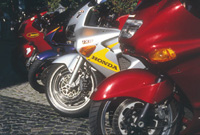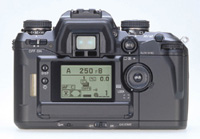First Look
Innovative New Minolta Maxxum 7
Just when we thought that cameras had reached the maximum level of technological achievement, Minolta engineers raised the bar significantly. Their new Maxxum 7 took a giant step beyond our expectations with some truly innovative technology. Resembling a digital SLR camera with its huge rear-mounted LCD monitor, it is a hybrid of familiar and futuristic with the large, conventional knobs plus entirely new controls and capabilities. When Minolta reps first demonstrated this new system behind closed doors in August 2000, I was overwhelmed. Would I need to become a computer programmer to actually use the Maxxum 7's multimode Navigation Display and some of its accessories? Apparently not, since an hour with the instruction manual--plus occasional reference later--proved to be all the education that I required. While shooting a few preliminary rolls of slide film, I became adept at accessing the most valuable of the unique features quickly. This brief report is not based on a full test so it is simply a preview of the technology and Maxxum 7 capabilities. Nonetheless, I did spend enough time with the camera, new 5600HS(D) flash, improved Vertical Grip VC-7, and a new D-series lens to offer a glimpse at their advantages. Look for a full test report with evaluations in a future issue of Shutterbug. In the meantime, consider the following information as to the incredible potential of this Maxxum system. |
|||
Camera Overview. This is a relatively compact body with some large control knobs and switches similar to those of the pro Maxxum 9. Naturally there are some electronic buttons, too, and a new focus area selector switch on the camera back. The latter is useful and easily accessed by both left and right-eyed photographers. A small door under the Navigation panel hides less frequently used controls but these are well marked like all the others. The flash mode selector switch is on the right side of the body, a logical location. The high-eyepoint finder is surprisingly bright and offers unusually high magnification--0.8x for ease of manual focus--plus diopter correction eyepiece. Navigation Display. This 1x1.5" oversized LCD panel provides more information than any other camera, a vast range, in fact. At first, this may lead to information overload, but you can ignore anything not of immediate interest: you press the [DISP] button to scroll to other screens with other data displays. When the camera is held in a vertical orientation, the display changes to vertical format--a great idea. Since I am near- sighted, I especially liked the extra large numerals and the illumination in low light. And the information as to each Custom Function--in simple text--will be very useful; there's no need to carry a cheat sheet as a reminder of the meaning of each of the 35 extra functions. The single most useful feature for photographers will be the depth of field bar graph, available only with D-series lenses. Focus on a subject, set the desired focal length and f/stop, and press the depth of field preview button. Now the display panel provides very specific data on the range of apparent sharpness: from 6-22', for example. Change the focal length, point of focus, or f/stop and the display provides the new data. Especially in low light at small apertures--where the viewing screen becomes very dark with depth of field preview--this feature should be greatly appreciated by serious photographers. |
|||
In time, much of the other available data will probably become useful, too, such as the scene brightness distribution display. This allows for a quick review of scene contrast: the exact relative brightness factor in 14 areas. Most photographers will never use all of the available data, just as they will not use all of the Custom Functions. Still, everyone should appreciate the technology and possible applications these provide. Superior Focus System. The Maxxum 800si already included a highly successful AF system, but the Maxxum 7 has more advanced technology with improved algorithm. According to Minolta, the 16-bit CPU of the Maxxum 7 has a data processing speed about five times faster for double the speed of focus tracking. The new nine-point AF system--with line sensors at various angles for reliable focus on any type of pattern--covers a very large area for framing flexibility and effective tracking focus. The central point has two sensors with both a + and x shape, a first for Minolta. This is said to increase focus accuracy with slow (to f/6.7) lenses and fast (f/2.8 or greater) lenses. Any of the nine points can be selected or simply set the camera for automatic focus point selection with the rear-mounted controls. The new AF/MF button allows for instant shifting between manual and autofocus with nearly all AF lenses. Focus can be manually changed after focus is locked in Single Shot AF mode, if desired. All this is made possible by an in-camera clutch mechanism, a first in the Minolta system. |
|||
Important Accessories. The new D lenses and HS(D) Program flash units offer several advantages worth clarifying. The D lenses include a distance encoder used in Advanced Distance Integration flash photography with one of the new HS(D) flash units or the built-in flash. By adding distance and Guide Number information to the flash exposure calculation, bright (or dark) subjects or backgrounds are less likely to create exposure errors. With other flash units, four-segment or Average TTL flash metering is selectable. When using a new HS(D) Program flash, high-speed synch becomes possible even in wireless off-camera flash photography. Note, too, that D lenses are required for the camera's depth of field bar graph to operate. Apparently, all other capabilities operate perfectly with other AF lenses and flash units, although an HS-model flash is required for high-speed synch. Because the Maxxum 7 body includes a built-in Distance Encoder, distance data is considered with multi-segment metering (without flash) with any Minolta AF lens. So there's no urgent need for D lenses or HS(D) flash units, although they do offer advantages with the Maxxum 7. The new optional Data Saver DS-100 accessory allows download of shooting data to a SmartMedia card--with data storage capacity for hundreds of rolls--for subsequent viewing on Navigation Display or uploading to a PC. This is useful if such data is important, because the camera's built-in memory can hold data for only seven rolls. Minolta got a lot of accolades for the new Vertical Grip VC-7 accessory, an ergonomically designed battery pack that is quite convenient. Its full set of secondary controls--placed in a much lower, more comfortable position--should make vertical shooting a pleasure. This accessory also accepts AA batteries, an inexpensive power source. Other Great Features. Minolta has included several capabilities worth noting. Interesting exposure control options include AE Lock useable with Manual operating mode for equivalent exposure settings at a variety of aperture/shutter speed combinations; a dual exposure compensation dial that can be set for 0.3 or 0.5EV increments; and a versatile AE bracketing mode. Other useful amenities include mirror lockup with the 2 sec self-timer, film chamber lock to prevent accidental opening in mid roll, and smooth trans focus control for defocused image areas without the need for a special lens. And if you reload a partially exposed roll of film, the camera can be set to automatically wind to the desired frame number. There's a great deal more of course, as noted in our Features section. All this makes the Maxxum 7 system one of the most versatile and technologically advanced SLR cameras ever. Hot Features
|
- Log in or register to post comments





































